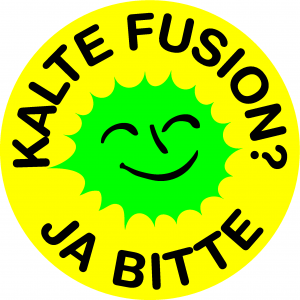
Wie alt ist das Logo “Atomkraft? Nein danke” eigentlich? Nach Fukushima hat der Bundestag hektisch eine Art Atomausstieg in zehn Jahren beschlossen. Doch die Bundesregierung denkt bei Alternativen weiterhin nur im ganz großen Maßstab, der die bestehende Energieinfrastruktur nicht umkrempelt. Eine neue, dezentrale Infrastruktur ist nicht nur möglich, sondern auch nötig. Hermann Scheer hat hat im Dokumentarfilm Die 4. Revolution Gründe genannt. Doch auch Scheer dachte noch nicht revolutionär genug.
Seit den 80er Jahren wird die Kalte Fusion erforscht. Entgegen Presseberichten, dass die Energieerzeugung duch Fusion von Atomkernen im kleinen Maßstab nicht reproduzierbar sei, gab es 2007 bereits mindestens 157 Experimente, bei denen dem Experiment mehr Energie entnommen als hineingesteckt wurde. Da sich darunter auch einige Experimente befinden, deren Energieproduktion Anwendungen in Aussicht stellte, stellte ich 2008 zur Diskussion, dass das Forschungsgebiet am kritischen Punkt sei. In anderen Worten: Mit einer evtl. relativ kleinen Investition von Forschungsgeldern könnte ein Durchbruch zur technischen Realisierung der KF als Energiequelle erreicht werden. Die Entwicklung hinsichtlich des Rossi-Reaktors macht Mut.
Wer heute noch an der KF als Energiequelle zweifelt, ist schlicht nicht informiert. Es ist Zeit, die Ablehnung alter Energiequellen zu überwinden und neue Energiequellen aktiv anzustreben und einzufordern. Je eher Forschungsgelder in Erforschung und Entwicklung wirklicher Alternativen wie der Kalten Fusion gesteckt werden, desto eher können wir auch die Probleme überwinden, die sich aus der alten Ordnung ergeben.
Ich habe das “Atomkraft? Nein danke”-Logo verändert in “Kalte Fusion? Ja bitte”. Lasst uns das neue Logo sichtbar machen: auf Webseiten, Transparenten, Flyern, Profilbildern…
Quelle:
http://complexity.haikolietz.de/?p=61

